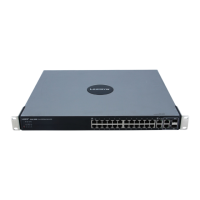

Do you have a question about the Cisco SD2008T-NA and is the answer not in the manual?
| Quality of Service (QoS) | Yes |
|---|---|
| Power over Ethernet | No |
| Mounting Type | Desktop |
| Jumbo Frame Support | Yes |
| Dimensions | 160 x 104 x 28 mm (6.3 x 4.1 x 1.1 in) |
| Operating Temperature | 0° to 40°C (32° to 104°F) |
| Storage Temperature | -20° to 70°C (-4° to 158°F) |
| Humidity | 10% to 90% noncondensing |
Describes the Cisco Unified Wireless Network (UWN) Solution for 802.11 wireless networking.
Explains the security components of the operating system for wireless LANs, including Layer 1, 2, and 3 security.
Details the web-browser interface (GUI) for configuring and monitoring controllers and access points.
Steps to protect GUI communication by enabling HTTPS, including certificate generation and loading.
Describes the command-line interface (CLI) for configuring, monitoring, and accessing debugging capabilities.
Explains the key concepts of ports, interfaces, and WLANs for controller connectivity.
Describes the default interface for in-band management and Layer 2 communications with access points.
Explains the AP-manager interface used for Layer 3 communications between controller and access points.
Provides instructions for configuring controller interfaces typically defined via the Startup Wizard or via GUI/CLI.
Step-by-step guide to configuring controller interfaces using the GUI.
Instructions for displaying and configuring management, AP-manager, virtual, and service-port interfaces via CLI.
Provides instructions for configuring dynamic interfaces using either the GUI or CLI.
Step-by-step guide to creating or editing dynamic interfaces using the GUI.
Instructions for configuring dynamic interfaces using the CLI.
Details how to view port status and edit configuration parameters for controller ports.
Describes Spanning Tree Protocol (STP) for path redundancy and preventing network loops.
Explains link aggregation (LAG) as a partial implementation of the 802.3ad port aggregation standard.
Explains methods to support more access points per port on 4400 series controllers.
Describes how to configure basic controller settings using the configuration wizard on CLI or GUI.
Provides instructions for resetting the controller to factory default settings using CLI or GUI.
Guide to creating and managing administrator accounts to prevent unauthorized access and configuration.
Steps to configure RADIUS server settings for accounting or authentication.
Advises changing default SNMP community strings ('public', 'private') for security reasons.
Advises changing default SNMP v3 username, authentication password, and privacy password for security.
Explains seamless client roaming across access points managed by the same or different controllers.
Explains CCX Layer 2 client roaming enhancements like access point assisted roaming and enhanced neighbor lists.
Explains configuring parameters affecting voice and video quality, like Call Admission Control and U-APSD.
Describes Call Admission Control (CAC) for maintaining QoS during wireless LAN congestion.
Explains the configuration of the Supervisor 720 to support the WiSM module in a Catalyst 6500 switch.
Details Cisco UWN Solution security, including Layer 1, 2, and 3 security components and policy management.
Implements industry-standard security like 802.1X and WPA with AES or TKIP encryption.
Describes security solutions for detecting, tagging, monitoring, and containing rogue access points.
Details how to mark rogue access points as known, alert, or contained to manage security.
Enables operators to monitor and configure controllers using a wireless client (excludes file transfers).
Explains how DHCP option 82 provides security by enabling the controller as a DHCP relay agent.
Describes access control lists (ACLs) as rules to limit interface access and traffic control.
Step-by-step guide to configuring ACLs using the controller GUI.
Instructions for configuring ACLs using the controller CLI.
Details Management Frame Protection (MFP) for 802.11 management frame authentication and DoS attack detection.
Steps to globally configure MFP or disable/re-enable it for specific WLANs or access points.
Explains the identity networking feature for applying QoS, ACLs, and VLANs based on user profiles.
Allows applying VLAN tagging, QoS, and ACLs to clients based on RADIUS attributes.
Describes the Cisco intrusion detection system (CIDS/IPS) for blocking clients involved in network attacks.
Describes configuring IDS signatures (bit-pattern matching rules) to identify attacks in 802.11 packets.
Explains how to use AES key wrap for more secure shared secrets between controller and RADIUS server.
Describes specifying maximum local database entries for storing user authentication information.
Describes the Cisco UWN Solution's ability to control up to 16 WLANs with unique security policies.
Details various sections for configuring WLANs, including display, creation, DHCP, security, and QoS.
Explains how WLANs can be configured to use internal or external DHCP servers.
Details the process of enabling MAC filtering at the WLAN level for client authorization.
Explains how to assign Layer 2 security settings to WLANs, including Static WEP and Dynamic 802.1X.
Explains how controllers control 802.1X dynamic keys and support 802.1X dynamic key settings.
Describes WPA1 and WPA2 as standards-based security solutions for data protection and access control.
Describes Cisco Key Integrity Protocol (CKIP) for encrypting 802.11 media using key permutation and MIC.
Explains how to configure Layer 3 security settings for a wireless LAN on the controller.
Explains Web authentication for improving WLAN security with SSL and active scripts.
Describes configuring Platinum, Gold, Silver, and Bronze QoS profiles for WLANs.
Explains Cisco Client Extensions (CCX) software and its features for wireless communication.
Allows selecting which WLANs are transmitted by access points on a per-access point basis.
Explains mapping users on a WLAN to interfaces and grouping access points for network administration.
Steps to create access point groups and assign them to WLANs.
Details how to assign access points to created access point groups using GUI or CLI.
Enables assigning different Layer 2 security policies to multiple WLANs with the same SSID.
Allows conditional redirection to a web page after successful 802.1X authentication.
Step-by-step guide to configuring conditional web redirect using the controller GUI.
Explains how lightweight access points discover and join controllers using LWAPP protocols.
Describes the Cisco 1000 series lightweight access point features, models, and configurations.
Describes the AP1510 as a wireless device for mesh connectivity, supporting client access and bridging.
Procedures to ensure proper operation before deploying AP1510: MAC address, mesh, and bridging parameters.
Explains the necessity of adding AP MAC addresses to the filter list for authorization.
Provides instructions for configuring mesh parameters to establish a connection with the controller.
Provides instructions for configuring the access point's role in the mesh network and related bridging parameters.
Explains using an upgrade tool to convert autonomous access points to lightweight mode.
Explains how controllers authorize access points using MICs or self-signed certificates (SSCs).
Explains Dynamic Frequency Selection (DFS) compliance with regulations for radio devices.
Explains how to use link tests (ping and CCX) to determine radio link quality.
Describes Cisco Discovery Protocol (CDP) for device discovery and interface updates.
Explains how to configure Power over Ethernet (PoE) for LWAPP-enabled access points powered by injectors or switches.
Step-by-step guide to configuring PoE using the controller GUI.
Instructions for configuring PoE using the controller CLI.
Describes configuring controllers to authorize access points using MICs via RADIUS servers.
Details built-in utilities for uploading and downloading software, certificates, and configuration files.
Explains the automatic upgrade of access points when the controller is upgraded.
Follows steps to upgrade controller software using the CLI, GUI, or wireless connection.
Describes saving configuration changes from volatile RAM to non-volatile NVRAM using commands.
Explains how to reset the controller and view the reboot process using CLI console.
Explains how to provide guest user access on WLANs by creating lobby administrator and guest user accounts.
Describes creating a lobby ambassador account via GUI or CLI for managing guest accounts.
Follows steps for a lobby ambassador to create guest user accounts using the controller GUI.
Describes web authentication as a Layer 3 security feature requiring valid username/password for IP traffic.
Provides instructions for specifying content and appearance of the web authentication login window.
Instructions for using or modifying the default web authentication login window via GUI or CLI.
Guides on using a customized login window configured on an external web server.
Explains how to compress and download customized login window files (webauth bundle) to the controller.
Explains Radio Resource Management (RRM) software for real-time RF management of wireless networks.
Explains dynamic channel assignment to avoid signal contention, collision, and interference.
Details how the controller dynamically controls access point transmit power based on real-time wireless LAN conditions.
Explains how RRM's coverage hole detection alerts administrators to needs for additional access points.
Describes how RRM load-balances clients across access points for optimal performance and capacity.
Defines an RF group as a cluster of controllers coordinating dynamic RRM calculations for scalability.
Provides instructions for configuring RF groups through either the GUI or the CLI.
Provides instructions for viewing RF group status through GUI or CLI.
Explains configuring access points to detect rogue access points by checking beacon/probe-response frames.
Step-by-step guide to enabling rogue access point detection using the GUI.
Instructions for enabling rogue access point detection using the CLI.
Describes modifying controller's dynamic RRM configuration parameters for optimal radio performance.
Step-by-step guide to configuring dynamic RRM parameters using the GUI.
Explains configuring parameters affecting client location calculations: broadcast requests and location calibration.
Defines a mobility group as a set of controllers for seamless client roaming and dynamic RF management.
Provides instructions for configuring controller mobility groups through GUI or CLI.
Explains using auto-anchor mobility to improve load balancing and security for roaming clients.
Provides instructions for configuring hybrid REAP on switches, controllers, and access points.
Provides instructions for configuring the controller for hybrid REAP using GUI or CLI.
Provides instructions for configuring an access point for hybrid REAP using controller GUI or CLI.
Provides guidelines for installing Cisco UWN Solution products, including antenna and power requirements.